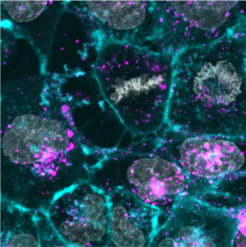Programming synthetic exosomes to optimize wound healing
Scientists create synthetic exosomes with natural functionalities and present their therapeutic application
Scientists from the Max Planck Institute for Medical Research in Heidelberg and colleagues at the DWI Leibniz Institute for Interactive Materials in Aachen have engineered synthetic exosomes that regulate cellular signaling during wound closure. The synthetic structures are built to resemble naturally occurring extracellular vesicles (EV) that play a fundamental role in communication between cells during various processes in our bodies. The scientists uncovered key mechanisms in the regulation of wound healing and the formation of new blood vessels. They designed and built programmable fully-synthetic EVs from scratch rather than isolating natural EVs from cells. Inspired by the roles of the natural counterparts, the scientists demonstrate for the first time that fully synthetic exosomes with therapeutic functions can be constructed. The results were recently published in Science Advances.
Extracellular vesicles mediate communication between cells
Efficient communication between cells is fundamental for multicellular organisms such as ourselves. Almost all processes in our bodies require coordinated interactions between cells as they form tissues and organs or, for example, work together during immune responses. Wound healing or the formation of new blood vessels likewise requires extensive cell-cell-signaling to ensure coordinated tissue regeneration, and cells in the skin use several mechanisms for this. One of these involves extracellular vesicles (EVs) − small droplets or compartments that can be loaded with various molecules and release these to transfer ‘information’ when they bind to cells or are taken up by them. However, little is known about the mechanisms and complex signaling processes that underlie extracellular vesicle communication. This is a major factor limiting their therapeutic application.

Learning by building: fully synthetic extracellular vesicles tweak the system
To develop a better understanding of EVs, scientists at the MPIMR and their collaborators chose a bottom-up synthetic biology approach. In the laboratory they designed and assembled fully synthetic extracellular vesicles to mimic precisely their natural counterparts in form and function. They hoped to assess more systematically their role during wound healing and to understand the relevance and mechanism of the individual components of the vesicles. Their bottom-up approach, using lipid droplets, enabled them to fine-tune the functionalities of the EVs and create a programmable EV technology. “We can potentially create synthetic vesicles with various kinds of characteristics – that is the beauty of the bottom-up approach. It gives us the chance to copy, tune and improve natural structures for different purposes”, says Oskar Staufer, postdoc in the Cellular Biophysics Department at the MPIMR and first author on the paper.
Therapeutic use of synthetic EVs during wound healing
To demonstrate the possible roles of synthetic EVs during wound healing processes, the researchers studied the healing behavior of human skin models cultured in the lab. When they treated wounds in these skins with their synthetic exosomes, they could show a much faster healing; and synthetic exosomes were able to improve in vitro the formation of new blood vessels, a process that is vital in several therapeutic contexts such as cardiac damage or tissue regeneration after surgery. Digging deeper into the mechanisms acting in the cells treated with the synthetic EVs, the scientists could identify crucial molecules within the EVs that are responsible for triggering the therapeutic effects. Identifying the key components is a key advance that in future might allow individually adjusted vesicles to be engineered for the treatment of many diseases like cancer, immune disorders or neurodegenerative diseases.
“Exosomes have raised high hopes in biomedicine for more than 20 years now. With this new technology in our hands, we can now synthesize exosomes with high purity on a therapeutic scale. This overcomes some major limitations that have impeded the application of exosomes for therapy, and could lead us to harness the possibilities of extracellular vesicle communication. Moreover, as we are working with precisely defined vesicle systems, we can now study the fundamental functions of EV in a very systematic way.”
